Birdwatcher-2 Polcarbonate (Lexan) Windows
Birdwatcher-2 Sailboat, designed by Phil Bolger
This page starts with ideas for the attachment of the raised deck sides, made from polycarbonate plastic, sold under various trade names, such as Lexan. Pictures of the completed windows will follow when the boat gets that far!
NOTE -- This page is a description of experiments that preceded the installation on the boat. The method, as described, was used and has caused no problems, as of May 2007. Time is still busy testing, however!
I have already purchased the 1/4-inch thick material from a plastics wholesale store. I bought two 4 x 8 foot sheets of clear for the sides, and a 4 x 4 foot half sheet of gray tint for the overhead of the rear compartment. All of this is Makrolon polycarbonate from Sheffield Plastics, and was purchased with abrasion-resistant (AR) coating. This coating is listed as having greater UV resistance, but I have never seen this quantified. A full sheet will produce the 5 pieces need for one side. The half sheet produces the two overhead pieces if the length is reduced to 48 inches from about 5-1/2 feet on the plans.
The next question to be answered is the sealing and fastening method. One issue is the much greater expansion rate of the plastic, relative to the wood to which it is fastened. Work by Birdwatcher-2 builder Jack Wyman was very helpful. In private correspondence Jack indicated the expansion of the pastic was much greater than that of the wood to which it is secured. Failure to account for this places huge stress on the screws and plastic.
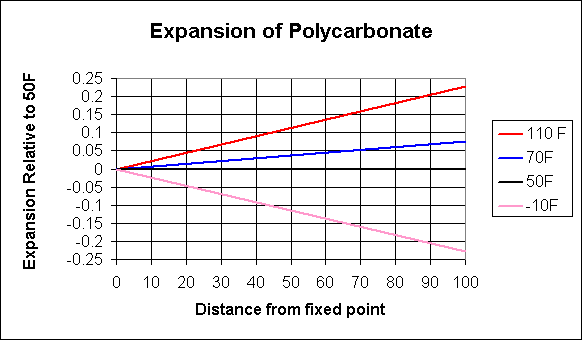
This graph summarizes this expansion, showing the amount of change for hot (110F or 43C) and cold (-10F or -23C). The graph could be inches, or other units such as cm, so long as both axes are the same. Also shown is a curve for room temperature, which Jack points out is not quite the middle of this range.
The distance involved for expansion is at most half of the window length or height. For BW2 this would be about 40 inches, for which the expansion/contraction at the extreme tmperatures is about +/-0.09 inches. The diameter of a #10 screw is 0.190 inches, and so the necessary hole would be a slot 0.190 + 2x0.090 or 0.370 inches long. But this applies only for the mounting hole at the ends of the window. It gets shorter as one moves to the center of the window, as seen in the graph.
In the vertical direction, the same effect occurs, but the distance is only 9 inches or so. As a practical matter, the holes near the center of the window can be circular and increasingly slotted as one progresses in the horizontal direction. To spread the pressure at the slots, flat washers are used uder the round-head screws.
Jack has worked out a detailed example that is
posted separately. He also shows how to be precise in determining the mounting relationship when the temperature is not in the center of the expected range. It is good study material for reading before making the holes!
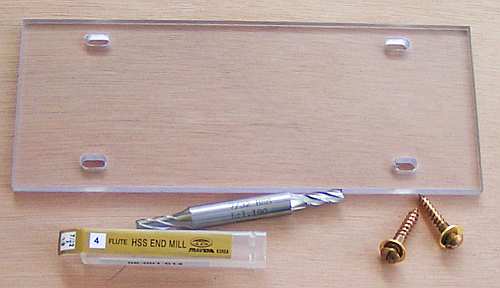
Here is a small window, put together to get some experience. The slots are of course, much larger than would be used for this tiny window. It follows Jack's plan for the far outside screws, modified some for available tooling. The holes are 7/32-inch diameter (0.219) and the slots are 0.400 inches long. The holes were placed 3/8-inches from the edge of the plastic. I drilled a 7/32 hole and then created the slot with an end mill, as shown. This tool is intended to cut on its side, so does a good job. I encountered absolutely no cutting problems as one would with acrylic plastics. The slots were cut on a milling machine that is convenient, but I see no reason why a drill press could not be used. A guide is needed to maintain the 3/8 edge spacing. The rotating end mill is a very sharp cutting tool and needs to be kept far from the operator's hands! The 7/32 end mill is not found everywhere, but Travers Tool is one source (their part 08-001-014). The screws are #10 round head wood screws. They are available in silicon bronze from Jamestown For the Birdwatcher, these should be 1-1/4 inches under the head. I could not get these when I called, so my original experiments were using 1-inch length. Jamestown also sells the washers.
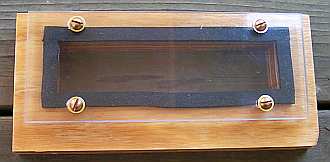
I cut a hole in some 1-inch thick plywood and assembled the sample. The screws were spaced 5-inches here. Flexing of the plastic was acceptable when tightened against the weather stripping (see below). I filled the back side with water, and not a drop leaked out after several hours. This doesn't mean very much, as the pressure of an inch of water is not much. But, so far, so good!
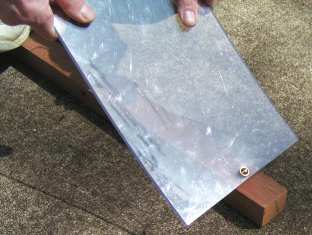
So how strong is all this? In past years, I used to hang out around junk yards. Old 1/4-inch Lexan machine guards showed up from time-to-time. Fortunately these hid from being tossed out in a corner of my basement. This yielded a test piece to see how strong the polycarbonate was when forced against a 1-inch #10 wood screw with flat washer. The single wood screw went into a scrap of wood that was dense, strong and tropical, but otherwise unidentified. About 10 inches from the screw, I pulled up, with what I would estimate to be 10 pounds. At this point the screw had first bent and then pulled out from the wood. The mechanical advantage would be roughly 30, so the force on the screw was perhaps 300 pounds. There was only a slight indentation on the plastic, corresponding to the edge of the flat washer. The screw bent to about 15 degrees from straight.
This test simulates the force from the inside of the boat trying to push the window out. If the screws are spaced 5-inches apart and the window is 20-inches high, it would be a pressure of about 300/[5x(20/2)] or 6 pounds per square inch. Water on the outside pushes against the mounting surface and this strength is limited by the frames of the raised deck.
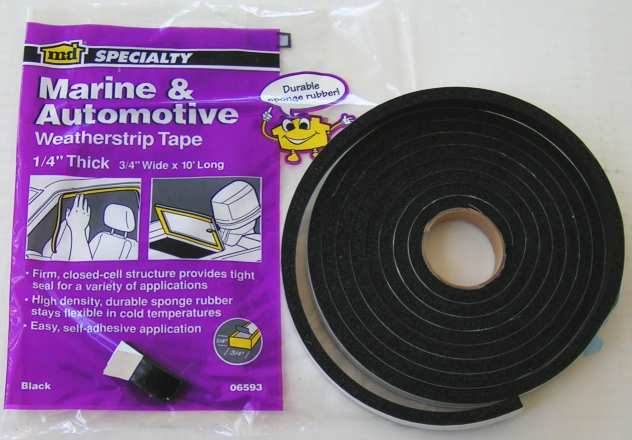
There are several types of weather stripping sold that might seal the windows. I was drawn to the black sponge rubber for many reasons. It has the necessary closed-cell structure (it is not a sponge). It should be the most UV resistant. It flexes and restores well. It is available with an adhesive backing tht seems to work very well. It does not have a permanent adhesion to the window. I was repelled by the higher cost than other materials, but what is new? The sample window above used this material, but in 3/8 width.
Back to Building Birdwatcher-2 main page
This was written 8 May 2006, and last revised 6 May 2007. Bob Larkin, Corvallis, Oregon